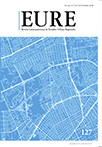Vectors of urban sprawl and their interaction with existing socioeconomic patterns in the city of Santiago
DOI:
https://doi.org/10.4067/S0250-71612016000300008Keywords:
urban sprawl, real estate market, segregationAbstract
In the context of the expansion of the metropolitan area of Santiago without master plans and based on real estate developers who decide the location and type of project to be developed (meeting certain conditions), the segregation of Santiago is reproduced in the new projects in the peri-urban area. The hypothesis of this investigation is that the unit price in a new housing development is explained by its relationship with other existing projects. The relation is measured considering travel times between projects, ranked by price. The results verify that projects seek proximity to the projects of the same type and with the socioeconomic groups to which they are associated. This indicates that while new developments aimed at a certain socioeconomic group can be located in other socioeconomic sectors, they do maintain relationships with their peers.
Downloads
Published
How to Cite
Issue
Section
License
Copyright (c) 2016 Revista EURE - Revista de Estudios Urbano Regionales

This work is licensed under a Creative Commons Attribution 4.0 International License.
Al momento de aceptar la publicación de sus artículos, los autores deberán formalizar la cesión de derechos de autor a EURE, según las condiciones establecidas por la Revista.
Ésta establece que el autor autoriza a EURE de manera gratuita, exclusiva e ilimitada a reproducir, editar, publicar, distribuir, publicitar, comercializar y traducir el artículo, a cualquier soporte conocido o por conocer y desarrollar.
Del mismo modo, los autores aseguran que el artículo propuesto es original, no publicado y no propuesto para tal fin a otro medio de difusión.


